Abstract
This paper draws attention to the issue of gender and ICT in relation to pupils’ educational abilities at Czech schools. The paper presents the current state of the addressed issue and a pilot research, which is part of a dissertation dealing with the issue from the perspective of diagnostics of differences in gender approaches to ICT concerning pupils of Czech primary schools. The aim of the paper is to outline the differences in the use of ICT and the opinions on them from the point of view of primary school pupils.
Keywords: GenderICTEducationCzech RepublicTeacher
Introduction
This article presents an outline of the available information on Gender and ICT in the field of education in the Czech education system and outlines a plan of a dissertation dealing with the addressed issue. It also includes evaluation of the pilot research using questionnaires, which has provided important information for the planning of a comprehensive research of the given issue that the authors of the paper deal with.
Problem Statement
The issue of ICT involvement in primary school teaching is described often in the professional circle, but the topic of ICT and pupils is neglected according to Zounek (2006, 52).
An important matter is the influence of gender aspects on the extent and level of these competencies. The issue of the relation of social and cultural influences towards gender and ICT at schools is not addressed by the well-known PISA research, nor by the extensive paper of the Open Society (Smetáčková, 2006) dealing with gender issues at Czech schools.(Fialová, Pavlíček, 2010)
Knowledge and skills in ICT and their use as a working tool or work environment are among the key competencies of the present and the future. Not only for this reason is it necessary to implement this knowledge in teaching.(Fialová, Pavlíček, 2010)
Gender and ICT Lessons
The leading educators point out the influence of gender aspects on ICT at schools. Průcha (2002) talks about sex and gender educational determinants and refers, among other things, to the German research (CULAS) on computer gender gap. Preuschoff (2007) emphasizes the need to create a friendly environment at schools for girls and specifies the issue of teaching technical subjects with regard to gender.
The report Educational Foundation Commission on Technology, Gender and Teacher Education from the US committee AAUW (Tech-Savvy, 2000) introduces the concept of e-culture that represents the social, psychological, educational and philosophical dimension of ICT.
Kristová (2004) claims that contemporary e-culture has distinctive masculine features, which can have a significant negative impact on educational reality. Negative impacts can be reflected in the passive or even resistant relationship of girls to ICT, which has consequences at schools – in the lack of competencies of girls for working with ICT, and in subsequent educational effects in the professional specialization of women. This is also evidenced by the current gender issues in the Czech Republic concerning the decrease of women in science. (Linková, 2016)
Research Questions
The primary research question for us is to find out and describe the perception of ICT in terms of gender among primary school pupils. We believe that the current availability of ICT has transformed the interests of pupils and their educational abilities. The modern teacher must therefore take into account the views of pupils of ICT as a possible source of information for their education.
Secondary Research Questions
Primary school pupils’ approach to ICT is influenced by many factors such as availability of ICT, social and financial background of pupils, computer skills and more. Our secondary research questions focus on such levels that affect pupils’ educational abilities. These include the following questions:
To find out what technologies pupils use at primary schools (comparison of age groups: 1st year, 4th–5th year, 7th–8th year)
Technology development is unstoppable, ICT users’ preferences are changing at a dizzying pace and it is necessary to respond to this. We believe that by involving modern and current ICT means into education will increase the motivation of pupils to learn.
To analyze the used technologies in terms of gender based on the above-mentioned findings.
The Czech education system works with a gender-equal environment, there are no differences between boys and girls (except physical education) during classes. We believe that there are differences in ICT approaches between boys and girls, and that this fact must be involved in teaching preparation using ICT means.
To find out how primary school pupils use the Internet (social networks, information sharing, learning).
The Internet is a gateway to information that can be, unfortunately, not always true. Pupils have access to the Internet using their smartphone almost anywhere within free Wi-Fi networks in restaurants, shopping centres and city areas. A good teacher should serve as the curator of this information for the pupils and know the pupils’ preference in the field of social media.
To analyze the use of the Internet in terms of gender based on the above-mentioned findings.
Purpose of the Study
At the beginning of our research, we carried out a collection of summaries and data from conducted domestic and international researches. This research has shown us that the issue of gender and ICT in the education system is almost absent or older than 10 years. We believe that during this time, there have been many new opportunities for boys and girls that can influence their perception of ICT as well as their educational results. There has also been a significant transformation of available ICT aids for teachers, which have fundamentally influenced the learning process (touch boards, tablets, online courses, etc.)
We would like to explore the resources used by pupils through our research and suggest their involvement in the learning process. We would also like to find out the extent to which pupils are affected by ICT means and what benefits or consequences ICT represents to them. The overall results for us will be deepening of the knowledge of the current issue and innovation of the current state of the learning process with ICT means that are no longer being taught by teachers (or school curriculum) but used and desired by the pupils themselves.
Research Methods
We select a generally and quantitatively qualitative design for our long-term research. The first phase – the use of non-standardized questionnaire and pilot research, which is processed and evaluated in this paper. We also want to use interviews with pupils, teachers and parents.
In order to determine the attitudes towards ICT, we would like to use the semantic differential – the relation to ICT by gender (perception of ICT). In order to determine the evolution of the relation to ICT, the Longitudinal probe of development and changes in the relationship towards ICT concerning pupils from the selected age group will be used for a period of 2.5 to 3 years.
Findings
As already mentioned several times in the paper, for the time being, we have carried out pilot research using questionnaires, which we want to use for the planning of the primary research in the subsequent years of work. We used a non-standardized questionnaire for the pilot research (translation of a standardized one enriched with our own research questions).This study involved 110 respondents at the target age of 11–12 years and the equal representation of boys and girls, out of which we excluded 17 wrong questionnaires due to incomplete information. In the assessment of the outcome of the pilot survey, gender differences are not yet taken into account.
The following is a subchapter, where a specific question of the research submitted to the respondents will be communicated. Figures are in the original language and the description of the question always has the translation and result evaluation. The numbering of figures is shifted due to questions determining the age and gender of the respondents
94.6 % of respondents have access to a computer or laptop outside the school environment, which is a big change compared to the last 10 years, when computers were not present in every household, and children often used PCs at school for the first time.
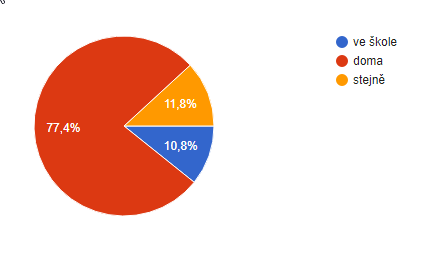
77.4 % of respondents use computer more often at school than at home.11.8 % of respondents use PC as often at school as at home. These answers may be influenced by teacher’s form of teaching or by the pupils’ backgrounds.
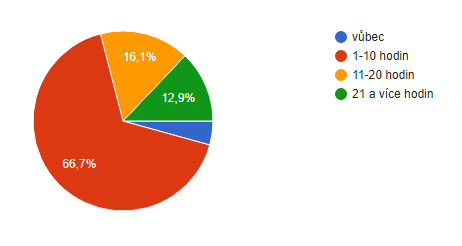
Most pupils aged 11–12 use PC in the range of 1–10 h per week (66.7 %).16.1% of pupils use PC 11–20 h per week and 12.9 % of them even use it over 21h per week. Pupils who said they did not use it at all may use a different portable device (tablet, smartphone, …). Therefore, it is necessary to emphasize that these may not be pupils with no access to technology at all.
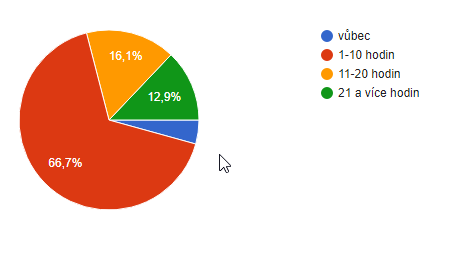
Pupils most often use PCs to watch movies and listen to music (90.3 %), then for school preparation (68.8 %), and chat or other forms of electronic communication, except for email correspondence (64.5 %). Interestingly, only 57 % of respondents use computer to play games, while 44.1 % of respondents aged 11–12 had even used computer for shopping.
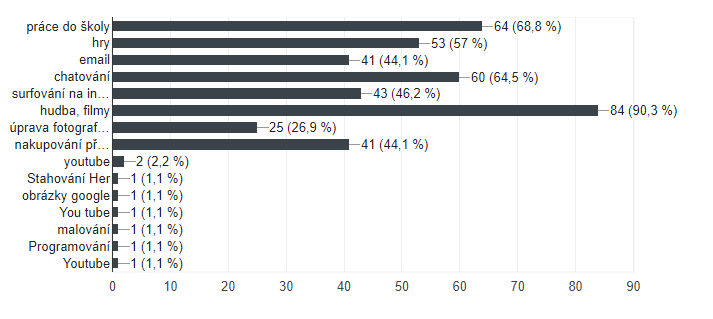
More than half of the respondent children (65.6 %) consider ICT classes to be fun at school. This chart will be one of the goals for the next gender comparison. We believe that the current ICT curriculum concept at Czech primary schools focuses more on skills for boys rather than girls.
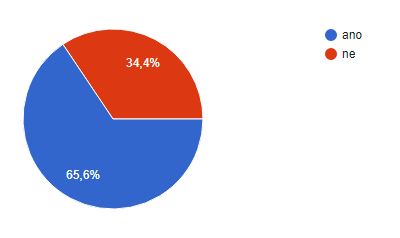
Respondents who enjoy ICT lessons at school either consider it fun (47.3 %) or consider the content of the classes interesting (37.6 %), and 36.6% of the respondents aged 11–12 even think computer literacy is important for their future profession, which is a very important finding, because pupils themselves are motivated from their childhood to deepen their ICT skills. Interestingly, according to question No. 6.16, most of them have no one in the neighbourhood encouraging them to dedicate themselves to ICT. It is therefore their own motivation. On the other hand, 32.3 % of the respondents are bored during ICT lessons; here, again, it is necessary to include the teacher’s ability to plan the lessons and motivate the pupils.
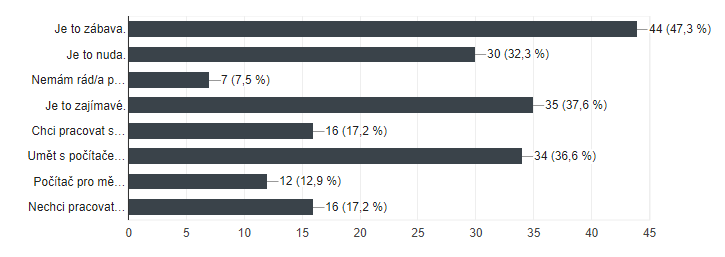
Approximately half of the respondents (50.5 %) evaluate the content of the ICT lessons at their school with the words “sometimes it is not so bad”, 35.5 % of whom evaluate it as very good. Only 14 % rate the content as boring.
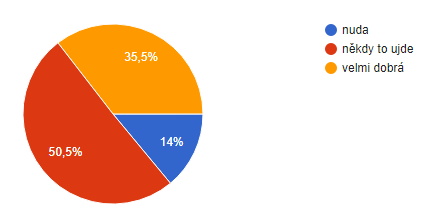
Here was the biggest gap in the opinions, as 50.5 % of respondents had ICT classes they wanted, and 49.5 % would like to modify the content of the ICT classes or otherwise change it to their satisfaction. This chart will also be important to compare from a gender perspective.
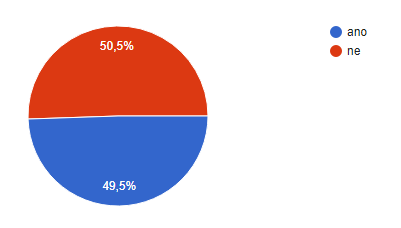
79.6 % of children like to solve tasks using a computer, only 20.4 % do not like to use computers to solve various tasks (homework, essays, presentations, etc.).
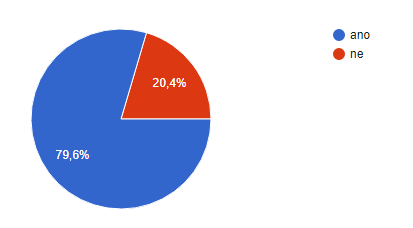
As much as 36.6 % of male and female respondents are afraid to answer ICT questions before their classmates because they feel frustrated by the possible mistaken answer and subsequent mockery from their classmates.
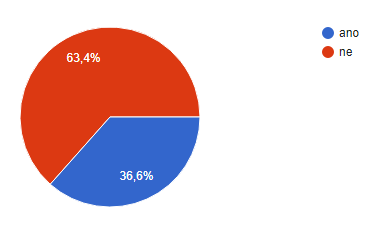
66.7 % of children consider boys to be better at PC skills than girls. This chart expresses stereotypes in society where girls are underestimated and are not expected to have such extensive ICT skills as boys. This stereotype must be demolished already at primary school, creating a friendly environment for girls during ICT lessons and enabling them to gain self-confidence in ICT skills.
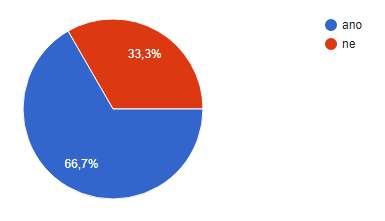
We wanted to give children the opportunity to describe how they perceive a person who works with computers, i.e. “IT person”. Positive adjectives such as smart (54.8 %), creative (50.5 %), patient (44.1 %), hardworking (39.8 %) and problem solving (35.5 %) are predominant. The negative adjectives with the majority of votes were unhealthy (19.4 %) and eccentric (16.1 %).This positive evaluation is a good example of a positive relationship to ICT as the content of their future professions.
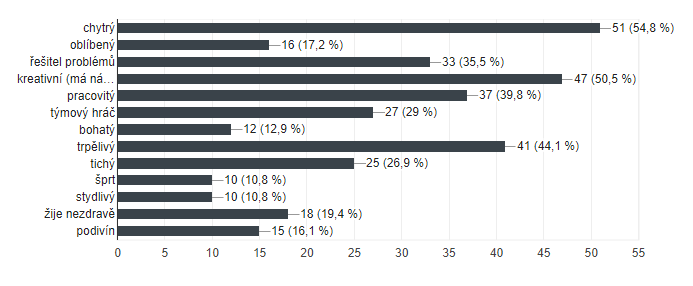
The reflection of a 21st-century society with smart phones on streets, buses, in shops, but also during sports, and unfortunately in cinemas and theatres, affects the younger generation, as 95.7 % of respondents use also smartphones besides PC. The second place was surprisingly taken by a printer (38.7 %), which we believe is due to school preparation. The third place was occupied by a tablet (36.6 %). Surprisingly, gaming consoles gained only 31.2 % of the votes, which slightly changes the idea that children use ICT mainly to play video games. The surprising result was a laptop that gained only 5.4 % and placed in the penultimate position before a phablet (a tablet that lets you insert a SIM card and use phone functions).
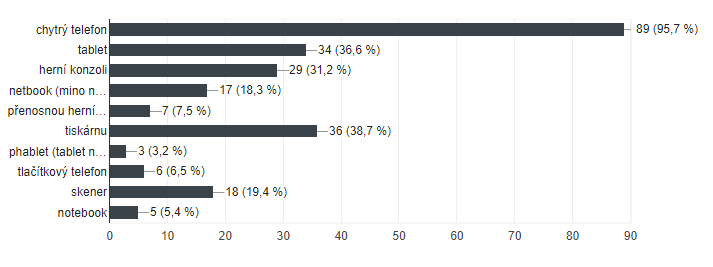
The blue field in the chart clearly shows the most used ICT equipment by children is a smartphone (86 %). Children are used to using a phone to listen to music, watch videos, and surf on the Internet. Phone becomes a pocket personal computer for them, allowing them to live on social networks and receive information from the Internet world without parental control. We see this as risky, because children can often become victims of crime without realizing this fact.
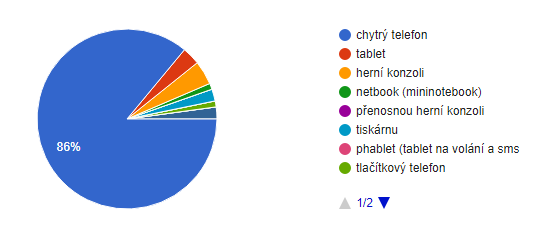
In this question, children should have indicated the number of hours per week they were using their most used ICT device (86 % smartphone).39.8 % of children use their device for more than 21 hours per week (at least 3 hours per day). It can therefore be a material for a pedagogical discussion, whether it is better to prevent children from using smartphones or to use them in school curriculums?
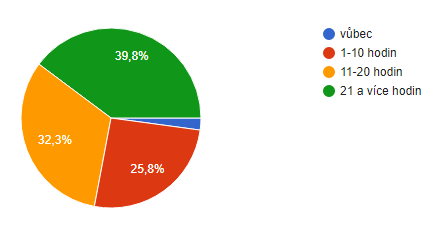
More than half of the children (59.1 %) do not have anyone in their neighbourhood who would recommend them to devote themselves to computers as their future occupation. They get these recommendations most often from their friends (22.6 %). Their fathers give these recommendations only in 10.8% and mothers in 7.5 % of cases. Children are thus mostly motivated by themselves.
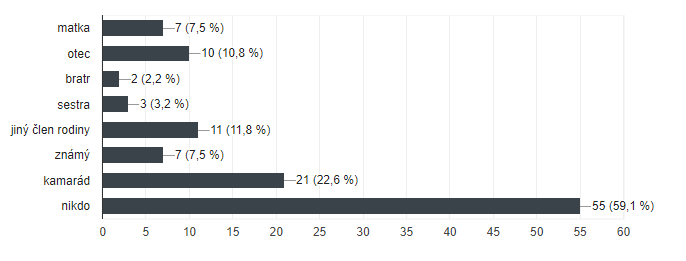
The following table contains the percentage of children’s accounts on social networks also in the original language (Czech).I repeat that these are primary school children, so they cannot even have a profile on most social networks. So they either lie about their age or they can create completely false identities. The reason for these findings is also the fact that their smartphones contain pre-installed social network applications, which bother them with various messages and pop-ups without registration and subsequent log-in. Only 2.2 % of children have no account on any social network.
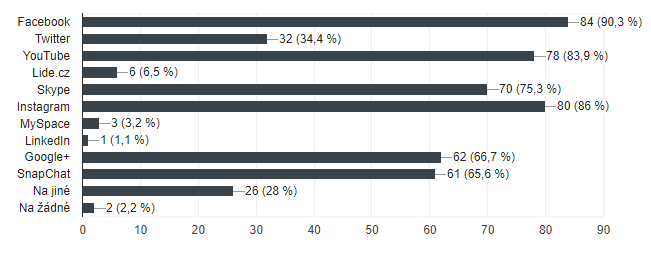
Here, you can see the most popular social network with children, Facebook (48.4 %), followed by YouTube (24.7 %), however, there is no user registration required to use the features, with third being Instagram (15.1 %).
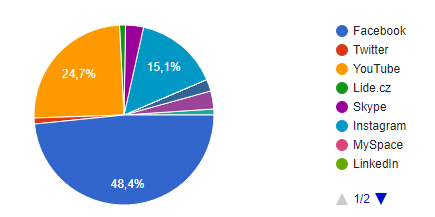
72.1 % of children think or rather agree that girls use social networks more than boys. We will compare this statement with reality in the following researches, as we believe that both genders use these networks the same, but there is only the stereotype of boys being players and programmers, while girls are perceived to be sharing their photos and statuses on social networks.
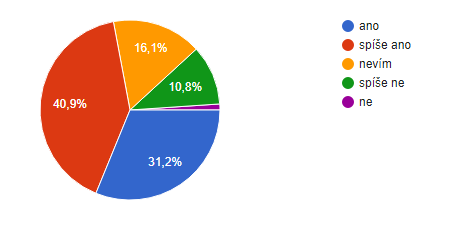
A little paradox compared to the previous questions is the fact that children consider a person who spends a lot of time on social networks as lonely (47.3%), but also as one who have a lot of friends (35.3 %), apparently the phrase “has a lot of friends” is to be blamed here, because it is not specified whether they are real or “virtual” friends. The topic of discussion could then be the formulation “real”. 23.7 % consider the person as someone who lives unhealthy, who is quiet (16.1 %), but also arrogant (16.1 %) and stupid (14 %). Conversely, 11.8 % of children consider such person to be smart, but also aggressive (12.9 %)!
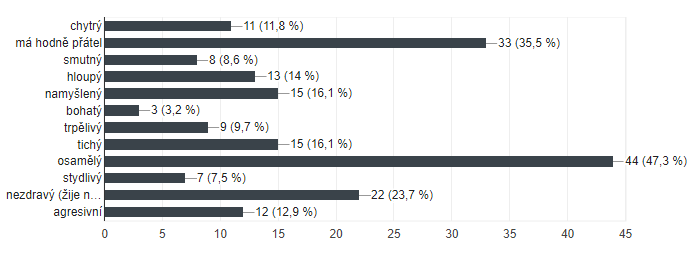
Respondents had a very positive response towards video games as a means of secondary learning.94.6 % even think that video games help them directly (67.7 %) or rather help them (26.9 %) with learning. Whether it is about improving English or not. In the Czech Republic, most of the distributed games are in English, or only with Czech subtitles and only on PC. Console players have only a tiny amount of games with Czech localization. Some games can help children “experience” a number of significant historical moments from our history (such as the popular Assassins Creed series).A modern teacher should reflect this fact and not perceive video games simply as fun and source of violence, as they can also be used positively for pedagogical activities.
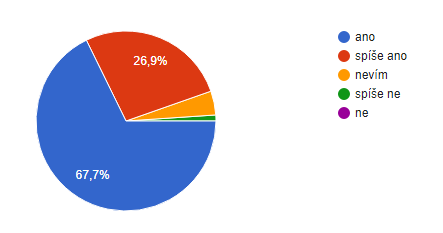
Conclusion
This pilot survey identified important information about the use of ICT by children aged 11–12. Questions include information about children’s own opinions about ICT and about the content of their ICT lessons. We also focused on their perception of ICT as a tool for future professions and, last but not least, as a means of spending their free time.
Primary school pupils and their opinion on ICT
Children aged 11–12 perceive ICT devices around themselves as positive tools. They use them to make their preparation for school subjects easier, they create various essays and print materials for school assignments. Nearly every child has access to a computer or laptop at home. The vast majority of children also have a smartphone and 1–3 social networks accounts, mostly Facebook, YouTube and Instagram. After all, watching videos, movies, and listening to music is their most common activity on ICT devices; pupils spend an average of 1.5–3 hours a day with a smartphone, and roughly 1–2 hours a day on PC. They perceive ICT lessons to be rather interesting and fun at school, but they would like to adapt the content of the classes to what would be interesting to them and what would they like to learn, as they realize that ICT is an instrument that will be used by them during their future career. This is perceived directly by themselves, but their parents rarely guide them to work with ICT.
Playing video games is as common as social networks and media, but almost every pupil perceives video games as a positive learning tool.
ICT in the Czech education system and possible innovations
At Czech primary schools, there is one ICT lesson per week, which is very little in proportion to the time children spend with ICT. These classes include writing skills, theoretical knowledge of computer systems and work with the Internet or various graphic editors.
A touch panel is available at some schools during the rest of the classes, but it allows work for only one pupil or a small group of pupils. A means of innovation would be to include textbooks with touch panel software using school tablets for each child, but this is costly in financial terms and would require training for all educators, and school curriculum reworking. At the same time, there would also be the risk that teachers would not be able to check the content of pupils’ activity in classes and pupils would use the tablet for their own needs. Based on personal interviews with children, they would like to include their own smartphones into lessons, but there is, in addition to previous problems, also the risk of pointing to different social capabilities of parents, and this could lead to verbal bullying of pupils with cheaper devices. These rigours are very difficult to overcome, and therefore the enrichment of classes must arise mainly on the part of teachers and their deepening of ICT knowledge and interest in current trends in e-culture, predominantly the one concerning the age group of pupils they teach. For example, the use of modern sample materials, the inclusion of examples related to activities commonly used by children (which nowadays largely include the use of ICT).If we return to video games (94.6% of children perceive them as a positive means of learning), teachers should not force children to play video games, but they could present them as an example of a pictorial experience of a certain historical period rendered by the video game, and, for example, encourage pupils to search for real historical pieces or fiction. There are many possibilities of implementing modern technologies, but it is important to know these possibilities, to know the views of pupils of modern technologies and work with them within the teaching process. Teachers should always be a step ahead of their pupils in order to gain their respect and authority, although it is very difficult at the pace at which these technologies evolve.
Acknowledgments
This article was created in pursuance of a specific research with the support of the University of Hradec Králové.
References
- Fialová, I.,& Pavlíček, J. (2016). Gender a ICT ve škole. Praha, 2010. Dostupné z:
- <http://www.spomocnik.cz/pub/Gender_Fi_Pa.pdf˃.
- Janík, T., Knecht, P.,& Šebestová, S. (2011). Smíšený design v pedagogickém výzkumu:
- Sborník anotací příspěvků z 19. výroční konference České asociace pedagogického výzkumu. 1. vyd. Brno: Masarykova univerzita. ISBN 978-80-210-5553-7.
- Kubiatko, M. (2013) The Comparison of Different Age Groups on the Attitudes toward and the Use of ICT. Educational Science s: Theory & Practice, Turecko. ISSN 1303-0485. Vol. 13, no. 2, pp. 1263-1272.
- Kristová, M. (2004) Ženy a ICT. In Kontext: časopis pro gender a vědu, č. 3-4, Dostupné z: <http://genderaveda.cz˃.
- Linková, M. (2016). O postavení žen ve vědě. In Kontext: NKC Gender and science (audio), ČRo Plus. Dostupné z: <https://soundcloud.com/nkc-gender-and-science/marcela-linkova-a-arnost-marks-o-postaveni-zen-ve-vede-25516˃
- Maněnová, M. (2009) Učitel primárního vzdělávání ve vztahu k ICT: (výzkum současného stavu). 1. vyd. Hradec Králové: Gaudeamus. ISBN 978-80-7435-026-9.
- Pelgrum, W. J., Law, N. &Plomp, T. (Eds.) (2008). Pedagogy and ICT in schools around the world: findings from the SITES 2006 study. Hong Kong: CERC and Springer.
- Sak, P. a kol. (2007). Člověk a vzdělání v informační společnosti. Vzdělání a život v komputerizovaném světě. 1. vyd. Praha: Portál. 290 s. ISBN 978-80-7367-230-0.
- Preuschoff, G. (2007). Výchova dívek. Praha: Portál. ISBN 978-80-7367-207-2.
- Smetáčková, I. (Ed.) (2006). Gender ve škole. Příručka pro budoucí i současné učitelky a učitele. Otevřená společnost. ISBN 80-903331-5-X.
- Šmahel, D., & Štětka, V. (Eds.) (2009). Nová média. Sociální studia, Brno: FSS Masarykovy univerzity. ISSN 1214-813X, č. 2. 121 s.
- Tech-Savvy (2000). Educating Girls in the New Computer Age. By the AAUW Educational Foundation Commission on Technology, Gender, and Teacher Education. Washington. ISBN 1879922231.
- Wastiau, P., Blamire, R., Kearney, C., Quittre, V., Van De Gaer, E., & Monseur, C. (2013). The Use of ICT in Education: A Survey of Schools in Europe. European Journal of Education. ISSN 0141-8211. Vol. 48, no. 1, pp. 11-27.
- Zounek, J. (2006). ICT v životě základních škol. 1. vyd. Praha: TRITON. ISBN 80-7254-858-1.
Copyright information

This work is licensed under a Creative Commons Attribution-NonCommercial-NoDerivatives 4.0 International License.
About this article
Publication Date
16 October 2017
Article Doi
eBook ISBN
978-1-80296-030-3
Publisher
Future Academy
Volume
31
Print ISBN (optional)
-
Edition Number
1st Edition
Pages
1-1026
Subjects
Education, educational psychology, counselling psychology
Cite this article as:
Novotny, R., & Maněnová, M. (2017). Gender Differences In Attitudes To Technology In Czech Primary Education. In Z. Bekirogullari, M. Y. Minas, & R. X. Thambusamy (Eds.), ICEEPSY 2017: Education and Educational Psychology, vol 31. European Proceedings of Social and Behavioural Sciences (pp. 925-941). Future Academy. https://doi.org/10.15405/epsbs.2017.10.89

